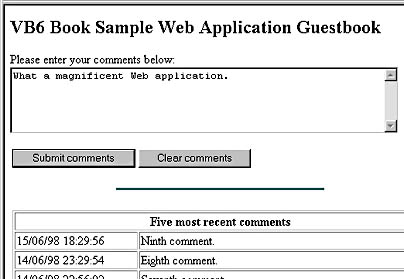
Figure 3-2 Guestbook Web page
Although the guestbook appears to be a single Web page, it has been created from two separate Web items. Everything above the horizontal rule comes from an HTML template called Guestbook that we have added to our Web class. The horizontal rule and the table below it come from a custom Web item called RecentComments. A hypertext link has been placed on our Welcome page. A connection has been made between the HREF attribute of the hyperlink and a custom event of the Welcome template, which we have called DisplayGuestbook. This custom event simply sets the NextItem property of the Web class to the Guestbook template and relies on the processing in the Respond event of the template to provide output to the browser. The Respond event for the Guestbook template sets the NextItem property to the RecentComments custom Web item before calling its own WriteTemplate method. At the end of the Guestbook template's Respond event, processing passes to the RecentComments custom Web item's Respond event. In this second Respond event a private procedure, GetComments-which is defined in the Web class, not in a Web item-is called to dynamically generate an HTML table definition containing the previous five comments. This table and a horizontal rule used to split the screen are written directly to the browser using the Response object of the Web server. The GetComments procedure uses ActiveX Data Objects (ADO) code to query our guestbook database. The query returns the comments to display in the Five Most Recent Comments table.
When the user has entered a comment, he or she clicks the button labeled Submit Comments to submit it. When this button is clicked all the responses generated by the form are gathered together and sent back to the server. Although individual input elements, like buttons or the comment text box, are not listed in the Web class designer, the form that contains them is listed in the designer. By connecting a custom event to the Form tag of the Guestbook template, we can program a response to the visitor submitting comments. Input controls in HTML are contained within sections called forms. The three attributes of forms that primarily concern us as IIS application developers in Visual Basic are: the ID attribute, which sets the name under which the form will be listed in the Web designer; the Action attribute, which we will be connecting to in order to trigger our response; and the Method attribute, which sets the mechanism by which data is sent from the browser to the server. For IIS applications written using Visual Basic, POST is the only value for the Method attribute that we can use. If we try to include an HTML template containing a Form tag with the Method attribute set to GET (or even without the Method attribute at all), the Web class designer issues a warning message (as shown in Figure 3-3) and tells us what it is going to change in our template.

Figure 3-3 Warning message issued by the Web class designer
When the POST method is used, data is received by the server in the Form collection property of the Request object. Each element of the Form that generates data creates a member in the Form collection using the element's Name attribute as its key in the collection. The data returned by each element is held in the Item property of each collection member. Since this is the default property of the collection, we can determine if the SubmitComments button was clicked using the following piece of code:
If LCase$(Request.Form("submitcomments")) = "submit comments" Then
The value returned by this type of button (a Submit button) is always the same as the text displayed on the button. If the button had not been clicked, there would be no member of the Form collection with the key "submitcomments." Having received the visitor's comment about our site (in the member of the Form collection with the key "comments"), we then store the comment in our database. Another procedure called AddComment takes care of this; again, this is a private method of the Web class. The visitor remains on the Guestbook page, which has the list of recent comments updated to reflect the visitor's newly added comment.